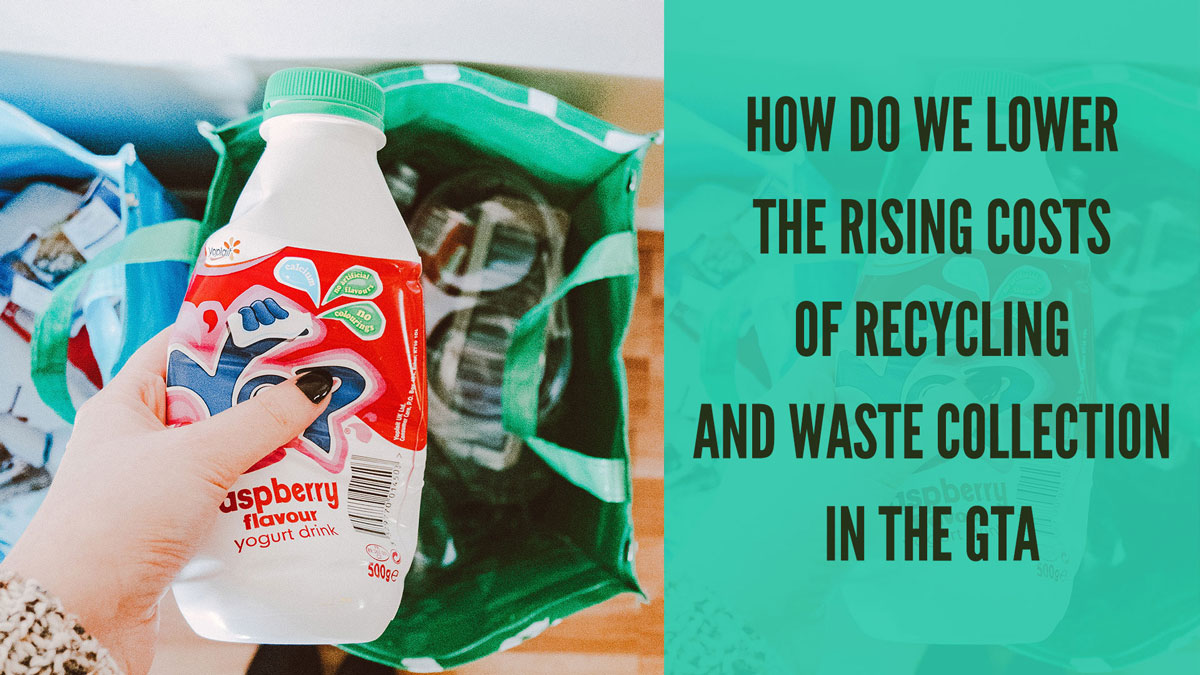How Do We Lower the Rising Costs of Recycling and Waste Collection in the GTA

“Help the environment. Recycle.” We’re told this. The message is in our schools, at work, in newspapers, and all over.
‘Recycle’ sounds nice. As a social concept, it makes sense. There’s a whole business behind recycling though.
The reality is that there’s a cost to recycling and waste collection in the GTA. The person who collects the waste must be paid. The facilities that sort the waste can only do so when rent, equipment, and utilities are covered.
If Toronto is to do its part and reduce waste, this means cost efficiencies will have to happen. Here’s the reality of the rising costs of recycling in our city.
Is recycling cost-effective in Toronto?
Recycling works best when it makes money. When a recycled material doesn’t have a market, we can’t sell it. As much as Toronto may want, recycling sometimes just isn’t possible. Waste collection costs are already high.
In 2017, Toronto made $16 million in revenues by selling recycled materials. According to estimates, this number has been cut in half since. The lowered cost of recycled commodities combined with contaminations has caused this.
Unfortunately, the cost of recycling in Toronto is rising faster than any other municipal service, including police, ambulance, or medical.
What is the cost of recycled commodities?
Commodities include paper, plastics, and metal. The cost for recycled materials like these are in a constant state of flux. It seems like every month we are seeing declines in market prices for aluminum or other materials. Here is a simple breakdown of the costs of recycling in Toronto in 2020.
The cost of recycling collection is $65/tonne.
The processing cost of recycling is $125/tonne.
How we justify those costs is by selling the materials we recycle. As mentioned, prices are always changing. On average, these are the approximate prices our recycling materials have been selling for.
Cardboard sells for $55/tonne.
Plastic water bottles sell for $460/tonne.
HDPE bottles, such as detergents, sell for $516/tonne.
Mixed plastics sell for $170/tonne.
Non-aluminum steel cans sell for $290/tonne.
Aluminum cans sell for $960/tonne.
What’s the most valuable recycling material in Toronto?
The most valuable recycling is aluminum. This is the money-maker. Despite the fact it makes up only a small percentage of the recycling collected, aluminum generates roughly a fourth of Toronto’s recycling revenues.
What has lowered recycled commodity prices worldwide?
Two years ago in 2018, China stopped accepting certain recycling products. This meant aluminum, plastics, and paper had nowhere to go. The market was flooded with product. This immediately dropped down pricing.
Prices are so low for some materials. Items like cheap plastics no longer have buyers. The future could change this. For now, continuing to collect low-cost recyclables isn’t feasible. Toronto waste collection facilities and recycling sorters are having to pay to get rid of materials like these.
The prices of mixed paper, cardboard, film plastic, and aluminum cans have fallen by double digits. This isn’t just a Toronto problem. Communities worldwide are feeling the pressure. Some American municipalities have even cancelled their recycling programs altogether.
What reduces the value of recycling in Toronto?
Contamination in blue bins can reduce the value of Toronto recycling to zero. More than 25 percent of the materials collected as recycling is not able to be recycled. This number is growing.
Homeowner errors lower city revenues. Buyers are picky. They understandably want value from the recycled materials they buy. What they don’t want is contaminated, lower quality product.
A piece of paper with a coffee stain on it is garbage. A greasy cardboard pizza box is garbage. Contamination turns recycling into waste. Another example is a half-filled jar of mayonnaise placed in a blue bin. This contaminates all of the contents. If the jar gets mixed throughout a recycling truck, it then ruins everything inside.
If we are going to lower the costs of recycling and waste collection, we must maximize value where we have it. Contamination numbers have to come down. The way to do this is through education.
What can we do to fix recycling costs in Toronto?
There are risks to recycling. You’re relying on the market to set the price. This isn’t ever going to change.
The best way to fix recycling costs in Toronto is with the right program infrastructure investments. Focus on what’s making profits, locally and worldwide. Aluminum cans have a high return. Prioritize, build around what’s building revenue, and reinvest in other money-making channels.
Toronto is fortunate to be a center of innovation. Cultivate partnerships with local companies, manufacturers, and organizations who are willing to buy and reuse recycled materials. New opportunities present every year.
Local networks are where the most revenue could potentially be derived. Local recycling purchasing partnerships mean lower transport costs and fewer expenses. It may be possible to develop local systems wherein Toronto can be less reliant on world commodity costs to derive revenues.
More recycling facilities are being built. This is going to mean more recycling product. From organics to electronics, there’s a way to derive revenues from these sources. Toronto simply doesn’t have the infrastructure yet to find them. But in time, the city will.
Extended Producer Responsibility is another concept some are advocating for. This would implement a system where producers of waste are responsible for its disposal. This diverts cost. Areas of BC already used an EPR system like this. It’s helped them lower costs. Maybe it can do similar things for Ontario.
How do we create a better recycling system in Toronto?
A better recycling system in Toronto is achievable through two processes. The first is to build the infrastructure and system. The second is to supply those systems.
Supply means to create more recycling. We do this by banning single-use disposables like plastic. Implement programs that incentivize alternative recycling materials over single-use disposables.
Every business, household, and person has the chance to become zero waste. That is to reduce landfill waste to zero. This would increase recycling rates tremendously which gives the city increased value in what they’re turning out.
If we are serious about reducing the costs of recycling and waste management, build better infrastructure and supply, supply, supply.
Are you looking for waste collection in the GTA? Contact Core Mini Bins. Improve your landfill diversion rate, increase recycling, and create a greener waste management system for yourself. It’s simple to do and we can help. Your recycling bin and waste disposal is our job.


